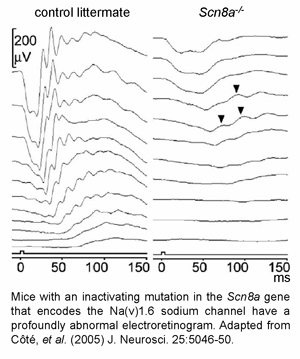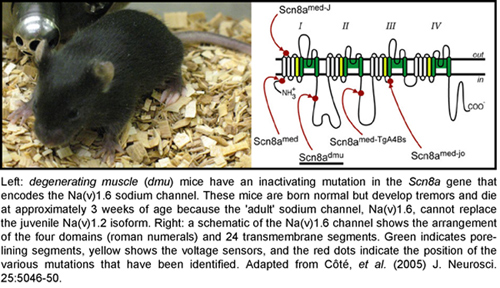Selected Publications
Alrashdi, B., Dawod, B., Tacke, S., Kuerten, S., Côté, P. D., Marshall, J. S.��(2021)��Mice Heterozygous for the Sodium Channel Scn8a (Nav1.6)��Have Reduced Inflammatory Responses During EAE and Following LPS��Challenge.��Frontiers in Immunology, 12, 533423
Smith, B. J., Côté, P. D., Tremblay, F. (2020) Voltage-gated sodium��channel-dependent retroaxonal modulation of photoreceptor function��during post-natal development in mice. Developmental Neurobiology, 2020 Nov 28. Epub��ahead of print.
Alrashdi, B., Dawod, B., Schampel, A., Tacke, S., Kuerten, S., Marshall, J. S., & Côté, P. D. (2019). Nav1.6 promotes inflammation and neuronal degeneration in a mouse model of multiple sclerosis. Journal of neuroinflammation, 16(1), 215.
Smith BJ, Côté PD, Tremblay F. (2017)��Contribution of Nav1.8 sodium channels to��retinal function.��Neuroscience��340: 279–90.
Smith BJ, Côté PD, Tremblay F. (2015)��Dopamine modulation of rod pathway��signaling��by��suppression of GABAC feedback to rod-driven depolarizing bipolar cells. Eur J Neurosci. 42(6):2258-70.
Sato T, Fujita M, Shimizu Y, Kanetaka H, Chu LW, Côté PD, Ichikawa H. (2015) Glial reaction in the spinal cord of the degenerating muscle mouse (Scn8a (dmu)). Neurochem Res. 40(1):124-9.
Smith BJ, Côté PD, Tremblay F. (2015)��D1 dopamine receptors modulate cone ON bipolar cell Nav channels to control daily rhythms in photopic vision. Chronobiol Int. 32(1):48-58.
Smith BJ, Wang X, Chauhan BC, Côté PD, Tremblay F. (2014) Contribution of retinal ganglion cells to the mouse electroretinogram. Doc Ophthalmol. 128(3):155-68.
Smith BJ, Tremblay F, Côté PD.��(2013)��Voltage-gated sodium channels contribute to the b-wave of the rodent electroretinogram by mediating input to rod bipolar cell
GABA(c) receptors.��Exp Eye Res. 116: 279-290.
Murphy JP, Côté PD, Pinto D. (2012)��Monitoring the Switch: The Warburg Effect and Targeted Proteomic Analysis of Cancer Metabolism.��Curr Proteomics.��9 (1): 26-39.
Smith BJ , Côté PD (2012) Reduced Retinal Function in the Absence of Nav1.6. PLoS ONE 7(2): e31476. doi:10.1371/journal.pone.0031476
Sato T, Shimizu Y, Kano M, Suzuki T, Kanetaka H, Chu LW, Côté PD, Shimauchi H, Ichikawa H. (2011) Increase of CGRP expression in motor endplates within fore and hind limb muscles of the degenerating muscl. mouse (Scn8a(dmu)). Cell Mol Neurobiol. 31(1):155-61.
Ichikawa H, Kano M, Shimizu Y, Suzuki T, Sawada E, Ono W, Chu LW, Côté PD. (2010) Increase of c-Fos and c-Jun expression in spinal and cranial motoneurons of the degenerating muscle mouse (Scn8a(dmu)). Cell Mol Neurobiol. 30(5): 737-42.
Shafey D, Côté PD, De Repentigny Y, Kothary R. (2005) siRNA mediated knockdown of the Survival of Motor Neuron (Smn) protein in cell culture and in transgenic mice. Exp Cell Res 311(1): 49-61.
Côté PD, De Repentigny Y, Coupland SG, Schwab Y, Roux M, Levinson SR, Kothary R. (2005) Physiological maturation of photoreceptors depends on the voltage-gated sodium channel NaV1.6 (Scn8a). J Neurosci. 25 (20): 5046-50.
Côté PD, Moukhles H, Carbonetto S. (2002) Dystroglycan is not required for localization of dystrophin, syntrophin, and neuronal nitric-oxide synthase at the sarcolemma but regulates integrin alpha 7B expression and caveolin-3 distribution. J Biol Chem. 277 (7): 4672-9.
De Repentigny Y, Côté PD, Pool M, Bernier G, Girard S, Vidal SM, Kothary R.
(2001) Pathological and genetic analysis of the degenerating muscle (dmu) mouse: a new allele of Scn8a. Hum Mol Genet. 10 (17): 1819-27.
Jacobson C, Côté PD, Rossi SG, Rotundo RL, Carbonetto S. (2001) The dystroglycan complex is necessary for stabilization of acetylcholine receptor clusters at neuromuscular junctions and formation of the synaptic basement membrane. J Cell Biol. 152 (3): 435-50.
Côté PD, Moukhles H, Lindenbaum M, Carbonetto S. (1999) Chimaeric mice deficient in dystroglycans develop muscular dystrophy and have disrupted myoneural synapses. Nat Genet. 23 (3): 338-42. SEE ALSO NEWS AND VIEWS ARTICLE: Chamberlain J (1999) The dynamics of dystroglycan Nat Genet. 23 (3): 256-8.
Links
|


 am interested in several aspects of the development and function of the nervous system in both health and disease. My group uses the mammalian retina to study neuronal biology because of its extensive postnatal development, layered cellular architecture, relatively simple circuitry, and accessibility. Indeed, because of these features, the retina is probably the best characterized part of the central nervous system. Here are two projects that are ongoing in my laboratory.
am interested in several aspects of the development and function of the nervous system in both health and disease. My group uses the mammalian retina to study neuronal biology because of its extensive postnatal development, layered cellular architecture, relatively simple circuitry, and accessibility. Indeed, because of these features, the retina is probably the best characterized part of the central nervous system. Here are two projects that are ongoing in my laboratory.
